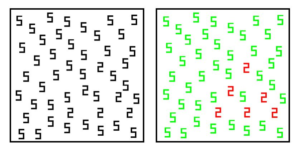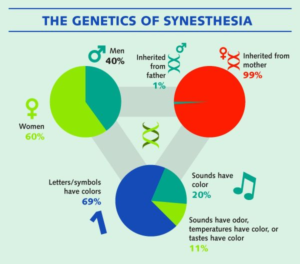Some people might taste shapes or maybe even hear colours… ‘But how?’ you may ask. Well, these people might just have synesthesia.
What is synesthesia?
Synesthesia is a neurological condition that causes a person to connect objects such as shapes, letters, numbers or maybe even people’s names with one of their senses, such as colour, flavour or smell. They often associate different sounds and tones with colours.
People with this condition are referred to as synesthetes. This mixing of the senses varies for each person, however; for example, some synesthetes may ‘sense’ green or purple colours when they hear soft music while others feel like they can taste the colour of an object when they look at it. There are also some who might feel something on their skin when they smell a specific scent or taste certain words.
Is this condition common?
There aren’t a lot of synesthetes, but there are probably more than you think. This condition has perplexed scientists for a long time now, especially as they used to think that synesthesia was quite rare when, in fact, approximately 4% of the population have some form of this condition.
There are many types of synesthesia, but the most common type is Grapheme-colour synesthesia. This is a specific form of synesthesia where people associate colours with specific letters and numbers.
If you are interested in knowing about a Grapheme-colour synesthete’s point of view and how they perceive the environment around them, then have a look at the diagram on the right. On the left, we clearly see a box with black numbers- this is how a normal person with no synesthesia would see the diagram. But if we take a closer look at the box on the right, we see exactly the same numbers, only there in two colours. The number 5 is in green while the number 2 is red- this is how a synesthete would see this diagram.

Some people have the ability to hear sounds in videos with no audio. Psychologist Chris Fassnidge calls this a “visually evoked auditory response”. Although it is not synesthesia, Fassnidge believes that it is a new form which requires further study. A 2008 study suggests that “visually evoked auditory responses” are quite common and affect 20-30% of the population. These people may not even realise that they are linking sounds with imagery!
Is synesthesia a disease?
No, it is not. Actually, many researchers have shown that synesthetes can perform better in tests of intelligence and memory. Synesthetes are not mentally ill.
Psychologist Daphne Maurer has theorized that all of us may be born with the neural connections that allow synesthesia, but most of us lose these connections as we grow older.

There are many people who have this condition but do not realize what it is, and while we do not have all the answers yet, studies have pointed out a few patterns:
- Synesthetes are more likely to be left-handed than right-handed.
- Synesthesia also appears to be inherited, with more people inheriting it from their mothers than their fathers.
Until we do have all the answers though, such conditions are always interesting to read about, and thanks to the internet, this is becoming increasingly easy to do… Stay curious!


